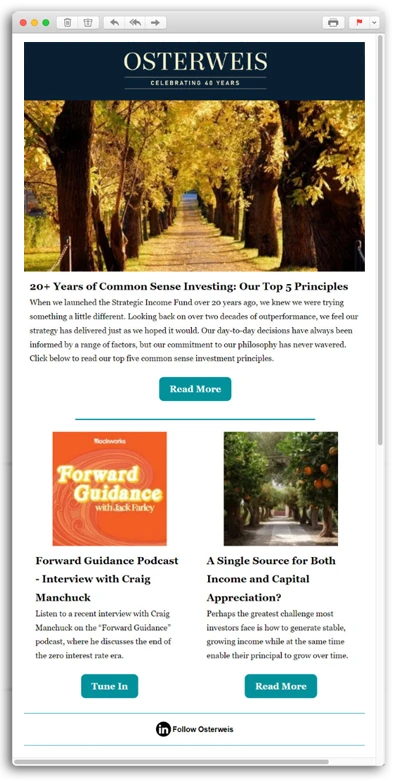Fourth Quarter Strategic Income Outlook
Published on October 10, 2024
Credit indices rallied during the third quarter, despite a variety of economic headwinds, and it appears FOMO (fear of missing out) is fueling the bullish sentiment more than fundamentals.
Up, Up, and Away
For those of us old enough to remember AM radio in 1967, we would only have to listen for a few minutes to hear the popular refrain, “Up, Up and Away ... my beautiful, my beautiful balloon.” That was the chorus of the multi-Grammy winning song by the 5th Dimension, and it was a classic example of the “sunshine pop” music that dominated the AM airwaves in the late 1960s. The musical genre was often associated with the sunny Southern California lifestyle popularized by groups like The Beach Boys, and its light and airy mood connoted a carefree, easy, happy world. While most of the songs were pleasant and easy to listen to, sunshine pop was really a glossy wrapper that eventually gave way to the darker, anti-war, anti-government counterculture that was brewing among the teens and young adults in America at the time. That was followed by hard, psychedelic, and progressive rock, which were all louder, angrier, and more rebellious than their predecessor. As we reflect on the performance of the major stock and bond indices in the third quarter, the lyrics of “Up, Up and Away” come to mind; it feels like a sunny, happy time, but we are wondering if looming geopolitical and global economic challenges are being somewhat glossed over by a fear of missing out (FOMO) that seems to be causing investors to pour cash blindly into risk assets and drive markets ever higher.
We are not experts on the global geopolitical landscape, and we certainly do not want to fearmonger about all the problems that exist in the world, but as we try to weigh the impact of significant trends or events and how they might impact the U.S. economy and the companies in which we invest, we cannot help but notice that the skies are not clear and cloudless. It is rare to have universal peace and calm confluent with strong economies in all of the world’s largest countries. There is always some potential negative somewhere that keeps us up at night. However, the global geopolitical environment today seems to be more fraught than normal. The Russia/Ukraine war shows no signs of ending anytime soon, Israel is now engaged in an escalating war on two fronts, the European and Chinese economies have experienced a prolonged period of significant weakness with precious few green shoots, immigration issues are creating moral, ethical, and economic dilemmas around the world, democratic countries worldwide are experiencing significant political instability, and the U.S. government’s debt burden is at yet another all-time high. That is not even considering the angst felt here at home over what economic and social impact the upcoming U.S. elections will have. The vitriolic rhetoric has become as bitter and hostile as we have ever seen it.
The list of concerns and worries goes on and on, and yet the U.S. equity market continues to make new highs. Some of this makes sense, however, as we have seen many of our companies continue to perform well, growing earnings and generating solid cash flows. Artificial intelligence has been a huge catalyst, turning chipmaker Nvidia into the third biggest company in the world, as measured by market capitalization, and the AI boom is still in its infancy. We expect to see new and exciting applications attract significant investment from venture capitalists and other growth investors. There will undoubtedly be some big winners, as there were with the advent of smartphones and the internet. That excitement is a key motivator driving investor behavior in some parts of the market and today seems to be creating a “risk-on” or “FOMO” market environment. As often happens, following a 2-year period of relative calm and strong performance in the stock and bond markets, investors become less focused on downside risk and more concerned with being invested in the next big thing. They frequently perceive less risk in these types of market environments than they often do at market bottoms. We are not suggesting that the lights are all flashing red, but we do think there are a growing number of areas where investors are ignoring some warning signs and are not being appropriately compensated for the risks they are taking. The Fed seems to agree.
On September 18, after many, many months of carping by policy doves that short-term rates were too restrictive, the Fed finally cut the federal funds rate by 50 basis points (bps). While the economic data has not been alarmingly weak, it has been ebbing. Also, a 50 bp initial cut is not at all out of character for the Fed when it begins an easing cycle. The Fed made initial 50 bp cuts in both 2001 and 2007, although the economy in both those periods was broadly more dire than what we see today. It was acting much more like the “lender of last resort” in those two periods and did not have the luxury of moving slowly. The 2019 mid-cycle rate cuts were the only time in the last four easing cycles that the Fed started off with a 25 bp cut, so we do not think there is anything too significant to read into the decision to start with 50 bps, even if the data may have suggested 25 bps was enough for now. The rate hikes in 2022 helped stanch inflation, but a concurrent sharp rise in the minimum wage in several states also caused some strain for small businesses and some levered corporate balance sheets. This could portend more significant economic weakness ahead. More on that later.
What is surprising to us is the magnitude and shape of the rally in interest rates over the past few months. As the rate cut approached, we were expecting the short end of the curve to rally, and indeed we have seen 1, 2, and 3-year Treasury rates fall by over 100 bps since the end of the second quarter. It is the magnitude of the rally in the longer end of the curve that defied our expectations — 7-year rates have fallen by 73 bps and 10-year rates by 62 bps during the quarter. In our view, neither of these moves seems consistent with the economic data right now, and the new levels suggest an overly optimistic expectation about the magnitude of future Fed cuts over the next 6-18 months. Too many investors are making bets that we are heading back to a near-zero rate regime similar to the era after the Great Financial Crisis, the likes of which we hope we will not see again in our lifetimes.
We continue to believe that there is some sticky inflation embedded in the economy that can easily be reignited by loosening policy too aggressively. Consequently, we think we may see longer rates range-bound in the 3.75-4.5% band for the 10-year Treasury, barring some economic calamity. Whether the election is won by a Democrat (continued high federal spending) or a Republican (tax cuts), high levels of government borrowing and deficits will keep our supply of government debt high, which makes it difficult to see how longer-term rates can fall materially from current levels. Our friend Jim Bianco, of Bianco Research, seems to agree. We have long been big fans of Jim’s, and his work on interest rates shows that over many economic cycles the average 2-year yield is approximately 42 bps over the fed funds rate. So, using the midpoint between the Fed’s and the market’s forecasts for next year, the fed funds rate may likely fall to about 3.125%, which puts the 2-year Treasury yield at about 3.55%, or about 10 bps away from where it is today. For the 10-year Treasury, it is quite a different story. According to Jim, the average 10yr/2yr spread is about 100 bps over most cycles. That suggests that if fed funds are cut to 3.125%, the 10-year Treasury should yield about 4.55%, or about 77 bps higher than where it stands today. This means the market is expecting a lot more rate cutting than we think is likely to occur in this regime. If Bianco is right, the rise in 10-year yields next year will be a significant performance headwind for longer-duration assets.
Propelled by the rally in the yield curve, as well as a rally in spreads, credit indices had a very strong third quarter. The confluence of those two factors seems somewhat misplaced to us. Investment grade indices have rallied sharply along with the move lower in rates, which makes sense, but high yield (HY) indices have rallied even more. The ICE BofA U.S. HY Index is up 5.28% for the quarter as many weaker credits and first-half laggards have rocketed higher, with previously depressed telecom, satellite, and CCC paper all benefitting from the risk-on rally. Typically, we see HY spreads move wider during a Fed rate-cutting regime, particularly among the lower-rated companies, as softer economic conditions tend to impact lower-rated borrowers more negatively than they do investment grade credits. However, in the third quarter, HY spreads tightened even as rates fell sharply. Although the HY market is a higher quality market than it has been historically, the rally in CCC bonds suggests there is a stronger reach for yield and higher coupons than we typically see at this point in the cycle – likely because the economy is in better shape than when the Fed typically cuts rates. But we expect some of these riskier parts of the market to correct if the Fed has to cut further due to persistently softer economic data, and regardless, we think expecting further material price appreciation and spread tightening from here, particularly in the CCC cohort, is overly optimistic. The ICE BofA CCC & Lower U.S. HY Index was up 11.55% in the quarter, which accounted for a significant portion of the total return of the broader HY index. The good news is that the coupons that we are earning on some newly issued, better-quality debt should continue to provide very solid, stable returns in the areas of the market that we find attractive. This supports our case that the broader HY market is not necessarily overpriced. For us, absolute yields matter more than spreads as a determinant of value.
There has been a very significant structural shift in the HY market that helps us justify the value proposition. At the end of the third quarter, the duration of the U.S. HY market was the lowest it has ever been. This means that the sensitivity of the underlying bond prices to changes in interest rates or spreads is, on average, lower than it has ever been. According to Barclays, adjusting today’s market spreads for its current lower duration suggests that even though we are near historically tight spread levels (though not for yields), the risk of a material broad markdown in HY bond prices is significantly reduced due to the lower duration that the asset class currently has. According to Barclays, the BB and B groups are both showing up as slightly cheap when evaluated on a spread-per-unit-of-duration basis, further supporting our view that spreads alone are not always a good valuation lens through which to view the high yield asset class.
Historically, people have looked at default levels to gauge market risk; however, with the covenant eliminations and the structural changes in many leveraged loans and HY bond documents over the past few years, it is important to also include distressed exchanges and Liability Management Exercises (LMEs) into the default calculations. According to JP Morgan, the dollar value of distressed exchanges in August was the 3rd highest monthly total on record. To date, 28 companies have completed HY bond or leveraged loan distressed exchanges totaling $35 billion, which makes up over 67% of the default activity this year. That nearly equals the 2008 record total of $36.4 billion of LME/distressed exchanges. That figure does not include private credit, however, where we are starting to see signs of distress. There was a very significant restructuring event in August when a large private creditor group agreed to a debt exchange that wiped out Vista Equity’s ownership of the software company Pluralsight. The group converted the majority of the original $1.5 billion of debt into equity and additionally had to inject $275 million of new money into the company to provide new liquidity. While this has been the first significant distressed exchange we have seen among the larger private credit lending deals since private credit exploded onto the scene, we do not think it will be the last. It seems private credit lenders, who have eagerly displaced banks as lenders to private equity (PE) sponsors to support their LBO transactions, can run into the same problem that other lenders to PE-backed firms experience: Over-levered companies, no matter from whom they borrow, eventually need to be restructured to make their capital structures work. If we do see a broader and more protracted slowdown take hold in 2025, we believe we will see many more LMEs take place among the PE-owned companies, regardless of who their lenders are. Fortunately, we have largely eschewed the PE-backed sector and thus avoided issues that have started to plague investors in leveraged loans, HY bonds, and private credit this year. These events have strengthened our resolve to continue to avoid lending to PE-owned companies as we have for the past several years.
We are very pleased with the positioning of the portfolio today, and we are happy to have taken advantage of the high yields that the inverted curve has given us over the last two years. Knowing that yield curve inversions have typically presaged recessions, we have systematically used this inversion as an opportunity to significantly upgrade the credit quality of the portfolio, and our current allocation to investment grade debt is close to the highest it has been since the 2008 financial crisis. This provides us with a great deal of ballast at the front end of the portfolio that should help protect us from any significant volatility or spread widening in credit that often occurs as the economy slows. As the shape of the curve continues to change, we will opportunistically look to redeploy our front-end paper a little further out on the curve into better opportunities in both investment grade and high yield companies as they present themselves. As always, we appreciate your trust and confidence in our ability to produce solid risk-adjusted returns in different market environments.
Carl Kaufman
Co-President, Co-Chief Executive Officer, Chief Investment Officer – Strategic Income & Managing Director – Fixed Income
Bradley Kane
Vice President & Portfolio Manager – Strategic Income
Craig Manchuck
Vice President & Portfolio Manager – Strategic Income
John Sheehan, CFA
Vice President & Portfolio Manager – Strategic Income
The Fund was rated 4 Stars against 592 funds Overall, 4 Stars against 592 funds over 3 Years, 5 Stars against 538 funds over 5 Years, 4 Stars against 424 funds over 10 Years in the High Yield Bond category based on risk-adjusted returns as of 2/28/25.
The Morningstar Rating™ for funds, or “star rating,” is calculated for mutual funds, variable annuity and variable life subaccounts, exchange-traded funds, closed-end funds, and separate accounts) with at least a three-year history. Exchange-traded funds and open-ended mutual funds are considered a single population for comparative purposes. It is calculated based on a Morningstar Risk-Adjusted Return measure that accounts for variation in a managed product’s monthly excess performance, placing more emphasis on downward variations and rewarding consistent performance. The top 10% of products in each product category receive 5 stars, the next 22.5% receive 4 stars, the next 35% receive 3 stars, the next 22.5% receive 2 stars, and the bottom 10% receive 1 star. The Overall Morningstar Rating for a managed product is derived from a weighted average of the performance figures associated with its three-, five-, and 10-year (if applicable) Morningstar Rating metrics. The weights are: 100% three-year rating for 36-59 months of total returns, 60% five-year rating/40% three-year rating for 60-119 months of total returns, and 50% 10-year rating/30% five-year rating/20% three-year rating for 120 or more months of total returns. While the 10-year overall star rating formula seems to give the most weight to the 10-year period, the most recent three-year period has the greatest impact because it is included in all three rating periods.
© 2025 Morningstar. All Rights Reserved. The information contained herein: (1) is proprietary to Morningstar and/or its content providers; (2) may not be copied or distributed; and (3) is not warranted to be accurate, complete or timely. Neither Morningstar nor its content providers are responsible for any damages or losses arising from any use of this information. Past performance does not guarantee future results.The Osterweis Funds are available by prospectus only. The Funds’ investment objectives, risks, charges, and expenses must be considered carefully before investing. The summary and statutory prospectuses contain this and other important information about the Funds. You may obtain a summary or statutory prospectus by calling toll free at (866) 236-0050, or by visiting www.osterweis.com/statpro. Please read the prospectus carefully before investing to ensure the Fund is appropriate for your goals and risk tolerance.
Mutual fund investing involves risk. Principal loss is possible.
The Osterweis Strategic Income Fund may invest in debt securities that are un-rated or rated below investment grade. Lower-rated securities may present an increased possibility of default, price volatility or illiquidity compared to higher-rated securities. The Fund may invest in foreign and emerging market securities, which involve greater volatility and political, economic and currency risks and differences in accounting methods. These risks may increase for emerging markets. Investments in debt securities typically decrease in value when interest rates rise. This risk is usually greater for longer-term debt securities. Small- and mid-capitalization companies tend to have limited liquidity and greater price volatility than large-capitalization companies. Higher turnover rates may result in increased transaction costs, which could impact performance. From time to time, the Fund may have concentrated positions in one or more sectors subjecting the Fund to sector emphasis risk. The Fund may invest in municipal securities which are subject to the risk of default.
Past performance does not guarantee future results.
This commentary contains the current opinions of the authors as of the date above, which are subject to change at any time, are not guaranteed, and should not be considered investment advice. This commentary has been distributed for informational purposes only and is not a recommendation or offer of any particular security, strategy, or investment product. Information contained herein has been obtained from sources believed to be reliable but is not guaranteed.
No part of this article may be reproduced in any form, or referred to in any other publication, without the express written permission of Osterweis Capital Management.
Current and future holdings are subject to risk.
As of 9/30/24 the Osterweis Strategic Income Fund did not hold positions in Nvidia, Vista Equity, or Pluralsight.
Investment grade/non-investment grade (high yield) categories and credit ratings breakdowns are based on ratings from Standard and Poor’s, which is a private independent rating service that assigns grades to bonds to represent their credit quality. The issues are evaluated based on such factors as the bond issuer’s financial strength and its ability to pay a bond’s principal and interest in a timely fashion. Standard and Poor’s ratings are expressed as letters ranging from ‘AAA’, which is the highest grade, to ‘D’, which is the lowest grade. A rating of BBB- or higher is considered investment grade and a rating below BBB- is considered non-investment grade. Other credit ratings agencies include Moody’s and Fitch, each of whom may have different ratings systems and methodologies.
A basis point is a unit that is equal to 1/100th of 1%.
Treasuries are securities sold by the federal government to consumers and investors to fund its operations. They are all backed by “the full faith and credit of the United States government” and thus are considered free of default risk.
Yield is the income return on an investment, such as the interest or dividends received from holding a particular security. A yield curve is a graph that plots bond yields vs. maturities, at a set point in time, assuming the bonds have equal credit quality. In the U.S., the yield curve generally refers to that of Treasuries.
Spread is the difference in yield between a risk-free asset such as a Treasury bond and another security with the same maturity but of lesser quality.
The fed funds rate is the rate at which depository institutions (banks) lend their reserve balances to other banks on an overnight basis.
ICE BofA U.S. High Yield Index tracks the performance of U.S. dollar denominated below-investment grade corporate debt publicly issued in the U.S. domestic market.
ICE BofA CCC & Lower U.S. High Yield Index is a subset of ICE BofA U.S. High Yield Index including all securities rated CCC1 or lower.
Effective 6/30/22, the ICE indices reflect transactions costs. Any ICE index data referenced herein is the property of ICE Data Indices, LLC, its affiliates (“ICE Data”) and/or its Third Party Suppliers and has been licensed for use by Osterweis Capital Management. ICE Data and its Third Party Suppliers accept no liability in connection with its use. See https://www.osterweis.com/glossary for a full copy of the Disclaimer.
These indices do not incur expenses and are not available for investment. The indices include reinvestment of dividends and/or interest.
Coupon is the interest rate paid by a bond. The coupon is typically paid semiannually.
Duration measures the sensitivity of a fixed income security’s price to changes in interest rates. Fixed income securities with longer durations generally have more volatile prices than those of comparable quality with shorter durations.
A leveraged buyout (LBO) is the acquisition of another company using a significant amount of borrowed money (bonds or loans) to meet the cost of acquisition. The assets of the company being acquired are often used as collateral for the loans, along with the assets of the acquiring company.
A leveraged loan is one that lenders extend to companies or individuals that already have considerable amounts of debt or a poor credit history.
Liability Management Exercises (LMEs) are transactions used by companies ahead of forthcoming maturities to reduce or manage their overall debt burden by way of tender offers (or debt buybacks) and exchange offers, allowing creditors to exchange their existing instruments for instruments with longer dated maturities and/or with other amended terms.
Osterweis Capital Management is the adviser to the Osterweis Funds, which are distributed by Quasar Distributors, LLC. [OCMI-617066-2024-10-07]








